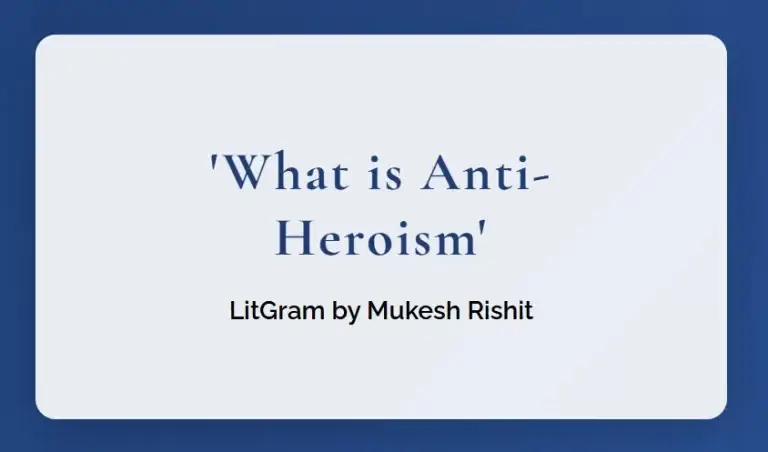Anti-heroism is a fascinating literary and cultural phenomenon that subverts traditional notions of heroism, offering a more nuanced portrayal of protagonists. These morally ambiguous characters, often burdened with flaws and inner conflicts, captivate audiences by reflecting the complexity of human nature. From ancient mythology to modern media, anti-heroes have left an indelible mark, challenging our perceptions of good and evil. Dive into the world of anti-heroes to explore their characteristics, evolution, and lasting appeal.
Table of Contents
Introduction to Anti-Heroism
What pops into your head when you think of a hero? A knight in shining armor maybe a superhero with a cape? Now, picture a character who’s gray, has shady reasons for their actions, and often steps off the straight and narrow path. Welcome to the interesting world of anti-heroism. Anti heroes have grabbed our attention for years showing a mix of traits that make us feel connected to them and want to know more. But what makes someone an anti-hero, and why do we feel so drawn to them?
Defining the Anti-Hero
An anti hero stands at the center of a story, but lacks the usual heroic traits like idealism, bravery, and strong morals. These characters often show qualities we might link to villains: self-interest, lies, or a wish to get even. Yet, despite these flaws, anti heroes still manage to draw sympathy, and at times even respect, because of how they show the complex sides of human nature.
The Appeal of the Anti-Hero
What makes anti heroes so appealing to us? Maybe it’s because they show the not-so-perfect parts of who we are. Unlike the usual heroes, who can seem too good to be true, anti heroes give us a more true-to-life, though flawed, picture of what it means to be human. They struggle with problems inside and out just like we do, which makes their stories grab our attention even more.
How Anti-Heroism Came to Be
Anti heroes have existed for a long time. We can find them in ancient stories. Homer’s “Odyssey” features Odysseus, who often tricks people to get what he wants. Shakespeare created Hamlet, a prince who struggles to make decisions and has a complicated sense of right and wrong. The concept of anti-heroism has changed over time adapting to different cultures and reflecting the spirit of each time period.
Traits of an Anti-Hero
Unclear Morals
A key feature of an anti hero is their unclear sense of right and wrong. They don’t always choose the “correct” path, and we can’t always tell why they do things. This fuzzy line between good and bad sets them apart from typical heroes, who follow a clear set of rules about what’s right and wrong.
Imperfect Qualities
Anti heroes have major flaws. They can be self-centered, quick to rage, or lacking in moral fiber. Yet, these shortcomings play a key role in shaping their personalities giving a gritty and true-to-life picture of human nature that viewers can identify with.
Relatability and Humanization
Even with their faults, anti heroes become more human than typical heroes often do. Their weak spots worries, and inner battles make them easier to understand letting viewers form real bonds with them.
Evolution of Anti Heroes
Classical Literature Examples
The anti-hero archetype has its roots in classic literature. Characters such as Don Quixote, who suffers from delusions of grandeur, and Hamlet, who grapples with existential dread, stand as early examples of the anti-hero.
Anti-Heroes in Modern Literature
Modern literature has given rise to a range of anti heroes who test social norms and stretch limits. Holden Caulfield from “The Catcher in the Rye” and Alex from “A Clockwork Orange” serve as key instances, each embodying a disappointment with what society expects.
Anti Heroes in Film and Television
TV screens have become a fertile ground to explore anti-heroism. Characters like Tony Soprano and Walter White change our understanding of what makes a protagonist grabbing viewers’ attention with their complex and deep personalities.
Psychology Behind Anti-Heroes
Why We Root for Anti Heroes
Psychology helps explain why we’re drawn to anti heroes. Some research shows that we support anti heroes because they show a mix of good and bad traits just like people we meet in our daily lives. This blend makes them easier to relate to and lets us see our own moral complexities reflected in them.
The Complexity of Good vs. Evil
Anti heroes make the difference between good and evil less clear causing us to question how we define these ideas. Their actions often stem from personal reasons instead of a clear sense of right and wrong, which adds depth to their stories.
Psychological Studies on Anti-Hero Worship
Studies show that our liking for anti heroes might come from a deeper need to see all sides of human behavior. By looking at both the dark and bright parts of human nature, anti heroes give us a fuller and more satisfying view of what it means to be human.
Popular Anti-Heroes in Literature
Classic Anti Heroes: Hamlet, Don Quixote
Hamlet consumed by his tragic indecision and philosophical thoughts, and Don Quixote driven by his misguided ideals, stand as some of the earliest anti heroes in literature. Their lasting appeal stems from their complex and relatable characters.
Modern Anti-Heroes: Holden Caulfield Alex from “A Clockwork Orange”
Holden Caulfield, the teenage cynic, and Alex, the ultra-violent yet magnetic narrator of “A Clockwork Orange,” show how modern literature has embraced and advanced the idea of the anti-hero. These characters test societal norms and force readers to question traditional morals.
Anti-Heroes in Film and Television
Iconic Anti-Heroes like Tony Soprano and Walter White
Tony Soprano, the mob boss with a conscience, and Walter White, the high school teacher turned meth kingpin, show us what a modern anti-hero on TV looks like. These characters struggle with tough choices and inner battles drawing viewers in with their many sides and actions that blur the line between right and wrong.
Anti-Heroes Make TV Dramas Work
Anti heroes have become a key part of TV dramas giving us something different from the usual hero types. Their twisty stories and surprise choices when it comes to right and wrong keep people watching and caring showing how much we still love main characters with flaws.
How Anti-Heroes Change Culture
Anti-Heroes and Today’s World
The popularity of anti-heroes in today’s media shows how society has changed to question things more and see them as less simple. These characters make sense in a time when simple ideas of good and bad don’t seem to capture what it’s like to be human.
Anti-Heroes Show How Culture Changes
Anti-heroes often show and criticize how culture changes. They act like a mirror to show how society’s values and rules are changing. By testing usual ideas of what’s right, they open the door to stories that have more layers and include more people.
Many Different Kinds of Anti-Heroes
We now see many different kinds of anti heroes, with characters from all sorts of backgrounds and identities taking the lead. This variety makes the genre better and shows the many different experiences and views that exist in the real world.
Anti-Heroes in Comics and Graphic Novels
The Rise of Anti-Heroes in Comic Books
Comic books serve as a breeding ground for anti heroes who challenge traditional ideas of heroism. Characters like Batman, who works outside the law, and Wolverine, who often acts on personal grudges, show this trend.
Notable Examples: Deadpool, The Punisher
Anti-heroes such as Deadpool, with his cheeky humor and loose morals, and The Punisher, with his brutal quest for justice, have become well-known figures in comics. Their popularity highlights how much people like complex characters with unclear morals.
Anti-Heroes in Mythology and Folklore
Mythical Anti-Heroes: Loki, Prometheus
Myth provides a wealth of anti-heroic characters. Loki, the god of mischief, and Prometheus, the titan who went against Zeus to give fire to humans, stand out as prime examples. Their tales carry moral uncertainty and defiance, traits that keep them captivating over time.
Folklore and Traditional Anti-Heroes
Folk tales also showcase anti heroes such as Robin Hood, the outlaw who breaks rules to aid the needy. These figures test social standards and spark deep talks about right and wrong.
Comparing Anti-Heroes to Traditional Heroes
Hero vs. Anti-Hero: What Makes Them Different?
The main contrast between a hero and an anti-hero stems from their moral framework. Heroes move through their worlds with a definite ethical direction, while anti heroes function in moral ambiguity often putting their own goals ahead of selfless aims.
Cases Where Roles Overlap
At times, the boundary between hero and anti-hero can become fuzzy. Characters like Batman, who shows both heroic and anti-heroic traits, demonstrate how intricate and multi-layered main characters can boost the richness of storytelling.
To wrap up
The Enduring Attraction of the Anti-Hero
From old stories to today’s shows, anti heroes grab our attention with their flaws, relatability, and moral gray areas. They give us a richer view of heroism pushing us to broaden our ideas about what makes a main character. As our world gets more complicated, the anti-hero’s knack for showing and dealing with that complexity keeps them popular.
FAQs
Why do people like anti-heroes so much in modern media?
Anti heroes click with today’s viewers because they paint a more true-to-life and layered picture of human nature. Their faults and moral uncertainties make them easy to connect with and interesting.
Can an anti-hero turn into a traditional hero?
Sure, an anti-hero can grow into a classic hero if they change a lot as a character and move past their moral gray areas to take on more selfless reasons.
How does an anti-hero differ from a villain?
Anti-heroes and villains might both have questionable morals, but anti-heroes are main characters who try to do good things even if they go about it in flawed or unusual ways. Villains however often want to hurt others or get ahead without caring about anyone else.
How do writers make an anti-hero someone readers can connect with?
Writers help readers connect with anti heroes by giving them weaknesses, reasons for what they do, and inner struggles that readers understand. This makes the character more human, so people can see parts of themselves in the anti-hero.


